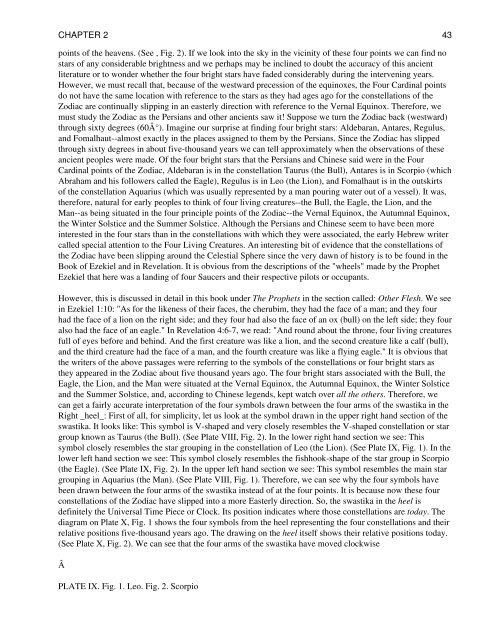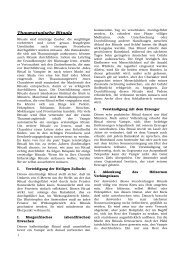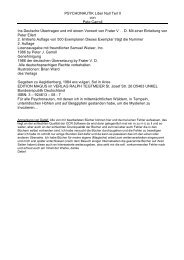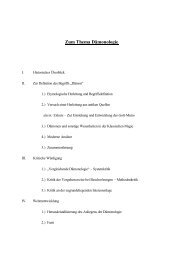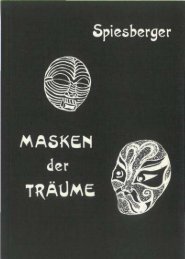CHAPTER 2 CHAPTER 3 CHAPTER 1 CHAPTER 2 CHAPTER 3 ...
CHAPTER 2 CHAPTER 3 CHAPTER 1 CHAPTER 2 CHAPTER 3 ...
CHAPTER 2 CHAPTER 3 CHAPTER 1 CHAPTER 2 CHAPTER 3 ...
You also want an ePaper? Increase the reach of your titles
YUMPU automatically turns print PDFs into web optimized ePapers that Google loves.
<strong>CHAPTER</strong> 2 43<br />
points of the heavens. (See , Fig. 2). If we look into the sky in the vicinity of these four points we can find no<br />
stars of any considerable brightness and we perhaps may be inclined to doubt the accuracy of this ancient<br />
literature or to wonder whether the four bright stars have faded considerably during the intervening years.<br />
However, we must recall that, because of the westward precession of the equinoxes, the Four Cardinal points<br />
do not have the same location with reference to the stars as they had ages ago for the constellations of the<br />
Zodiac are continually slipping in an easterly direction with reference to the Vernal Equinox. Therefore, we<br />
must study the Zodiac as the Persians and other ancients saw it! Suppose we turn the Zodiac back (westward)<br />
through sixty degrees (60°). Imagine our surprise at finding four bright stars: Aldebaran, Antares, Regulus,<br />
and Fomalhaut--almost exactly in the places assigned to them by the Persians. Since the Zodiac has slipped<br />
through sixty degrees in about five-thousand years we can tell approximately when the observations of these<br />
ancient peoples were made. Of the four bright stars that the Persians and Chinese said were in the Four<br />
Cardinal points of the Zodiac, Aldebaran is in the constellation Taurus (the Bull), Antares is in Scorpio (which<br />
Abraham and his followers called the Eagle), Regulus is in Leo (the Lion), and Fomalhaut is in the outskirts<br />
of the constellation Aquarius (which was usually represented by a man pouring water out of a vessel). It was,<br />
therefore, natural for early peoples to think of four living creatures--the Bull, the Eagle, the Lion, and the<br />
Man--as being situated in the four principle points of the Zodiac--the Vernal Equinox, the Autumnal Equinox,<br />
the Winter Solstice and the Summer Solstice. Although the Persians and Chinese seem to have been more<br />
interested in the four stars than in the constellations with which they were associated, the early Hebrew writer<br />
called special attention to the Four Living Creatures. An interesting bit of evidence that the constellations of<br />
the Zodiac have been slipping around the Celestial Sphere since the very dawn of history is to be found in the<br />
Book of Ezekiel and in Revelation. It is obvious from the descriptions of the "wheels" made by the Prophet<br />
Ezekiel that here was a landing of four Saucers and their respective pilots or occupants.<br />
However, this is discussed in detail in this book under The Prophets in the section called: Other Flesh. We see<br />
in Ezekiel 1:10: "As for the likeness of their faces, the cherubim, they had the face of a man; and they four<br />
had the face of a lion on the right side; and they four had also the face of an ox (bull) on the left side; they four<br />
also had the face of an eagle." In Revelation 4:6-7, we read: "And round about the throne, four living creatures<br />
full of eyes before and behind. And the first creature was like a lion, and the second creature like a calf (bull),<br />
and the third creature had the face of a man, and the fourth creature was like a flying eagle." It is obvious that<br />
the writers of the above passages were referring to the symbols of the constellations or four bright stars as<br />
they appeared in the Zodiac about five thousand years ago. The four bright stars associated with the Bull, the<br />
Eagle, the Lion, and the Man were situated at the Vernal Equinox, the Autumnal Equinox, the Winter Solstice<br />
and the Summer Solstice, and, according to Chinese legends, kept watch over all the others. Therefore, we<br />
can get a fairly accurate interpretation of the four symbols drawn between the four arms of the swastika in the<br />
Right _heel_: First of all, for simplicity, let us look at the symbol drawn in the upper right hand section of the<br />
swastika. It looks like: This symbol is V-shaped and very closely resembles the V-shaped constellation or star<br />
group known as Taurus (the Bull). (See Plate VIII, Fig. 2). In the lower right hand section we see: This<br />
symbol closely resembles the star grouping in the constellation of Leo (the Lion). (See Plate IX, Fig. 1). In the<br />
lower left hand section we see: This symbol closely resembles the fishhook-shape of the star group in Scorpio<br />
(the Eagle). (See Plate IX, Fig. 2). In the upper left hand section we see: This symbol resembles the main star<br />
grouping in Aquarius (the Man). (See Plate VIII, Fig. 1). Therefore, we can see why the four symbols have<br />
been drawn between the four arms of the swastika instead of at the four points. It is because now these four<br />
constellations of the Zodiac have slipped into a more Easterly direction. So, the swastika in the heel is<br />
definitely the Universal Time Piece or Clock. Its position indicates where those constellations are today. The<br />
diagram on Plate X, Fig. 1 shows the four symbols from the heel representing the four constellations and their<br />
relative positions five-thousand years ago. The drawing on the heel itself shows their relative positions today.<br />
(See Plate X, Fig. 2). We can see that the four arms of the swastika have moved clockwise<br />
Â<br />
PLATE IX. Fig. 1. Leo. Fig. 2. Scorpio


